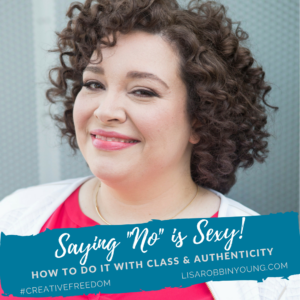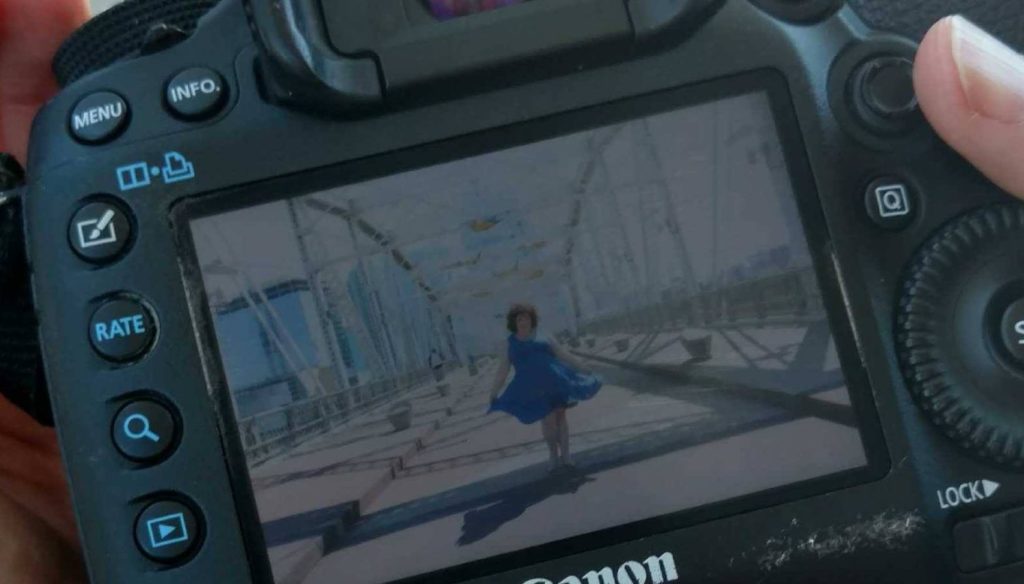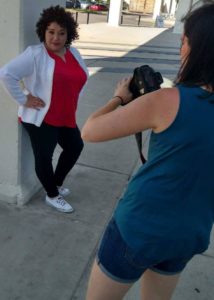 This is Season Four, Episode Four. Where we talk about how to say "no" with class and authenticity. Got someone who wants to pick your brain, ask you for a discount, or - GASP! - work for exposure? Need a classy way to say "um, no thanks!" without burning bridges or sounding like a jerk? You need this episode!
This is Season Four, Episode Four. Where we talk about how to say "no" with class and authenticity. Got someone who wants to pick your brain, ask you for a discount, or - GASP! - work for exposure? Need a classy way to say "um, no thanks!" without burning bridges or sounding like a jerk? You need this episode!
Being a doormat in your business sucks, quite frankly. It's also potentially a sign of co-dependence, which is one of our 5 Symptoms of Underearning. If you're saying yes to everyone and everything except yourself, it's time to re-wire your brain. Saying "no" is sexy, y'all, and today, I'm sharing tips to help you say it with class & authenticity. This is the third episode in a Summer-long series that deals with different aspects and triggers for underearning.
Need help with that whole "re-wiring" thang? Look no further than Overcoming Underearning for Creative Entrepreneurs. In just 5-weeks, you could build the clarity, confidence, and courage you need to finally beat the cycle of underearning once and for all. Plus, you get individualized email support throughout the program, so you're never alone in this journey.
Download Season 4 Episode 4 | iTunes | Anchor | Stitcher
If you’re listening to just the podcast, you’re only getting about a third of the deal. Catch the Creative Freedom web series or join me on Facebook on Fridays at 5:30pm Central time for a LIVE Q&A about the week's topic.
3:08 - The alternative to the vicious cycle of deadbeat clients and doing work you hate.
04:32 - The "Beef Stew" problem that shows up when you don't stand your ground and say "no".
9:00 - The importance of honoring boundaries
12:06 - What to say when someone is trying to talk you down on your rates
16:00 - The importance of saying "no" and trusting others to do their own work.
19:16 - The greatest lesson my Mom ever taught me.
24:03 - What happens when the desire to "not lose" ruins your plan to succeed (and how to fix it)
Still trying to decide what to say yes to, and what to say no to? There's an exercise in the Rising Tide this week for you to try.
Not a member? It's free! Click here to join our Rising Tide to get email updates, transcripts, and bonus downloadables only available to members.
Mentioned in this episode:
Music: "Welcome to the Show" by Kevin MacLeod
Licensed under Creative Commons: By Attribution 3.0
Every day, we're tasked with thousands of decisions.
How many? Well, Cornell University researchers said we make about 226 decisions just on FOOD in an average day.
The total number for adults is somewhere in the range of 35,000 decisions a day. Many of them are impulsive, and logic-driven (pro/con, etc.), but that's STILL a lot of remotely conscious decision making each and every day of your adult life.
Kids only make about 3000 decisions a day. Ahhh, those were simpler times, right?
Here's a decision making tool that I've used for myself and my clients for years now - one that gets immediate results and gives you clarity when you've probably been feeling stuck on something for a while, maybe even overwhelmed at the prospect of having to choose from several equally appealing (or unappealing, as the case may be) options.

This is just one of the tools you'll be working with in Your Breakout Year - my summer workshop for creative entrepreneurs. This program is designed to help you map out AND implement a clear path to a six-figure annual revenue stream.
THAT piece is the idea/concept/decision that holds the most energy for you, so that's where you need to act first (yes, even if you don't WANT to, which is another thing altogether).
The brain is a funny thing. When we take something out of one modality into another, our brain gets to work on the problem in a different way. By changing the way you assess the situation (from emotional or logical to visual), your brain has a new way of looking at the problem. The old block (which is probably a conflict between emotional and logical) is interrupted and you're able to make a decision so that you can move forward.
Often times, it doesn't matter what you decide, only that you finally make a decision so that you can get momentum again. So even if you "randomly" select a paper ball, you've made a decision and can move forward.
If you're a tactile processor, you might ACTUALLY write each option on a piece of paper and throw them on the floor. But then you've got a lot of cleaning up to do, which is totally NOT my jam. 🙂
Like I said, the messy room technique is is a powerful tool that's quick and easy to use to get clarity now, and get moving again.
Whether you're starting from scratch, been hobbling along at this for a while, or you're ready to expand and add a new revenue stream to your creative business, Your Breakout Year is the exact process I've used with clients - for over a decade now - to help them get clear on what really matters and build out a business model that gets them there faster, with less hustle, and more ease.
Courses and classes alone don't get the job done. You'll just end up with a lot of information and zero implementation. This is an implementation-heavy program because I believe that if you do the work, you'll get results. So doing the work is baked into the program. No "learn now, implement later" in Your Breakout Year. Implement as you learn, decide what works and what doesn't, cut the fluff, and see real financial results in your business.
There are still a few spots left for early bird pricing, and a 4 installment payment option to make it budget friendly.
If you're ready to find your right audience and make good money doing what you love without selling your soul, join me for Your Breakout Year.
This week I had an AMAZING photo shoot that's been several months in the making. I knew when I landed in Nashville, starting over would take up a good portion of my first year here. I also knew that I had projects that still needed to move forward: I've been sitting on Creative Freedom for a while now, and The Damn Whippersnappers have promised to visit this summer for a recording session. So with a new book and new music in the works, of COURSE I needed to get the website redone.
Only, I didn't know anyone in this town, so I had no idea how long I'd have to wait, how much it would cost, or anything. Luckily, my best friend, Google helped me out. I met Emily, a wardrobe stylist from Effortlesstyle here in Nashville. She came over, looked at my closet and said "let's just start from scratch, okay?"
hee. hee.

While I know how to clean up, I've never been at the bleeding edge of style, and I told her that. My closet is full of black, black, and more black - with a splash of solid color here and there. So I gave her a budget and she went to work. A week or so later, we met for the fitting. There was really only one piece I couldn't bring myself to like. Everything else was wonderful - and a lot of it I wouldn't have picked for myself. Like this floral top. When I first looked at it, all the voices in my head took a swing at me:
"Oh, you're too big to wear white!"
"That floral print is just going to draw all kinds of attention that you don't want."
I swallowed hard when she showed it too me. I knew Emily could sense my reluctance. "Just try it on." she politely insisted.
I did. We found a keeper.
I had just raised my threshold of belief around what was possible for my wardrobe. Emily's a professional that's been doing this for years. Despite that, it was hard to trust her at first because I didn't know her. I didn't believe she could style a plus-sized momma like me.
Luckily, she made it easy to like her, and her ensemble choices were on point, so trust came quickly.
Which was good, because the hair and makeup artist I had originally asked to do the shoot booked herself another appointment and was unable to make our shoot date. It wasn't her fault. I was trying to coordinate all the details myself, and things didn't come together. Frantic, I asked Emily if she had any suggestions.
Panic turned to relief, but I had no idea how much I'd be paying for TWO people instead of one.
I swallowed hard again, and just trusted the process.
I arrive at Emily's house on the day of the shoot for hair and makeup. Mind you, two total strangers are about to have their way with my head. The ONLY thing keeping me from not showing up is the commitment I made to my photographer, Ashley.
That, and I trusted Emily. She hadn't steered me wrong yet, so I figured she wasn't going to start now.

I knock on the door, walk in, and I'm greeted by two of the sunniest, most enthusiastic women I've ever met. Both hard-working artists, both incredibly talented. Both eager to make magic happen.
Why did I ever doubt Emily?
Within minutes they are both working on me: Angela at the front, Genia at the back. We're chatting, really connecting, and they're making it easy for me to trust them. But...
I don't even know how much time has gone by, I can't see a mirror, and I'm still too nervous to eat any of the snacks Emily's put out for us. I did manage to down a glass of water, because I kept telling myself "it's gonna be hot outside, you don't want to die of heat stroke!"
Still, I think I managed to keep my self-doubt to myself as we talked about building a business doing what you love, something I'm pretty passionate about. My fear was, hopefully, masked by my enthusiasm for profitable creative businesses.

When they finished, I snapped a quick photo of my glam team and off we went to meet Ashley at Cumberland Park. When I got in my car, I had all I could do to keep from crying. I looked GOOD! Like, I almost didn't recognize myself. I had a vision of what I wanted for the shoot, and even hired Duane "The Hair Fairy" Edlao to cut my hair before I met these ladies to make sure that it would do what we wanted it to do. But to see it actually come to life?
Whoa.
We headed off toward Nissan Stadium to meet Ashley for the shoot. This is the first time we've met in person, and she looks happy, so I'm feeling more relaxed at this point. She's got some ideas about how to get in all the wardrobe changes and make the most of our time together.
The first few pictures felt awkward to me - because my inner critic was having her way.

There was a couple sitting at a picnic table across the way. They both stopped and looked up as my entourage pulled up with all our gear. I joked about being famous, but inside I was a self-conscious mess.
Despite these women all being super talented professionals, my inner critic was having her way with me. I told Ashley to "just shoot everything" because I knew that candid moments would probably end up making the most "natural" shots, plus we'd get some behind-the-scenes shots, too, which would be great for me to share with my clients in A-club. In truth, I was just hoping that, if she shot everything, there might be something that I could use.
Good thing Emily was listening, because she took some great candids, too. Like the shot of Angela, above, touching up my face, or this one, which is quickly becoming one of my favorites.
When I saw the first photo, I knew I was in good hands and I could relax. That's when we had REAL fun!
We joked, got silly, and just enjoyed being together - creatives whose only agenda was to create. Make magic happen. That was all we had to do, and when we could really let loose and trust each other, poof! The magic was there naturally.
The rest of the hour-long shoot went by fast, and it really felt like we were a team - working together to tell a compelling visual story. I look forward to seeing the proofs that Ashley took. Here's a sneak peek from the back of Ashley's camera...

This photo shoot was a massive investment in the future of my company, and it would be easy to just stop there...
...But that would be the least important part of the story.

As the pictures started appearing, people on Facebook started asking me what the shoot was for. It was easy to say "new book, new album, new website," but that wasn't entirely true. It was also a "new me" of sorts.
In the past, I would have tried to DIY as much as possible and keep everything on the cheap - not to be efficient or save money (though those are the excuses I would have used), but because of my own self-worth.
I put at least ten times the money into this shoot than any other shoot I've ever done. I'm not saying that to brag. I still feel strange about it, to be honest. I tell you this because there was a time in my life where I didn't believe I was WORTHY of investing "that kind of money" in me or my dreams.
Some days, I still struggle with my worthiness.
My early photo shoots were courtesy of my kid, or good friends who were skilled with a camera. I actually hired a photographer and hair/makeup artist for my last shoot because I wanted to get some specific shots for the album. I was leery then about spending "that kind of money" on a project that had no guarantee of completion, let alone success. But I was so happy with the results that I used those pictures all over the interwebs for a couple of years.

This time, I had a team of three incredible women who had my back the entire time (four, counting my photographer!). They probably had no idea of the "who do you think you are?" trash talk my inner critic was laying on me. At least, I hope they didn't. I am thrilled that they made it SO easy for me to just be ME in front of the camera.
The next day, I was talking with one of my coaches about my book, online course, and live event all built around the foundation of Creative Freedom. One of the last things she said to me was about the pricing for my upcoming event. I've been in a holding pattern for WEEEEEEKS because I haven't been able to decide how to price it or how and when to offer the online version. I told her I feel confident that I could easily charge twice the price because I believe it'll bring a solid 5-10x return on investment, but I was keeping the intro rate low because I wanted to fill the program (totally an ego thing, by the way).
When she looked at my pricing and asked about my motivations, she reminded me that sometimes, when we offer discounts and low-ball our pricing, it doesn't actually empower our clients, because we're modeling a behavior that comes from a place of scarcity instead of abundance. She then asked me "what if, by lowering your prices, you're denying your clients from having the same experience you just had at your photo shoot?"
Eyes Opened.
If you've got a healthy relationship with money, this probably doesn't apply to you, but if you struggle with naming a price that feels right to you because your inner critic is asking "who will pay that?" - this could be helpful.
The answer to the "who will pay that?" question isn't found in the circle of people you've been begging to buy from you. The answer is found in the faces of the people who light up when you enter the room and say "where have you been all my life!?!?"
Sadly, most of us build our careers around the former and not the latter.
This is one of the reasons I encourage my clients to develop a $25,000 offer... not because anyone will ever buy it (though it does happen), but because it gets you thinking differently, so that when you offer something for $2k or $5k, you'll feel more confident around the real value you bring to your work.
What could happen (for you and your potential clients) if you just created and asked for the price you want without all the baggage attached?
Because it doesn't matter what price you pick, there will always be someone that can't or won't pay it. But there are also probably a few people who will.
Owning your dreams, without selling your soul. Finding yourself and building a life and business that works for who you really are and what really matters to you. Making good money doing what you LOVE (and all the ladies from my shoot love what they do). THAT is what Creative Freedom is about, and I can't wait to share more of this new evolution with you.
Oh, and tickets for the virtual workshop and online event will be on sale soon. If you're not already on my list, get there to be one of the first to know about it!
No sooner had I finished my lunch when the phone rang. It was my oldest.
"Hey, are you okay?"
"Not really, Mom. Aunt Dian died."
Less than an hour later, I was on the road to Michigan. 9 hours later, I'm crashing at my ex-husband's house for the night. That meant I wasn't able to have any studio recording time this week to film new episodes of Creative Freedom for you.
And that turned out to be an important business lesson I didn't want you to miss.
People are born. People die. Stuff happens in "the in between years." You leave a thumbprint on the lives of many people in those years.
As a creative entrepreneur, our work is often an extension of who we are. It's not like you can put it on the shelf at 5pm and call it a day. It follows you everywhere, like a toddler who just wants more Mommy time. It wakes you from sleep. It keeps you up at night.
So it can be hard to really step back and NOT work on your business in some form or another.
In theory, I suppose you could say that we never REALLY step away, since inspiration is everywhere. But taking an intentional break is important to restore your spirit. ESPECIALLY if someone close to you has died.
This week's Special Edition episode is me, after a good bout of ugly crying, explaining why I'm taking a short hiatus.
Taking a hiatus is a great way to get a fresh perspective. I was already planning changes and updates to the Incubator, A-Club, and my coaching program, but hadn't had the bandwidth to really consider how I wanted to handle it. This time away frees up my brain to work on all the "back burner" stuff that's been marinating. And the best part is that my brain handles that without my intervention. I can be focused on my family, my own self-care, and just being present to the grief and mourning that I need to process.
Even when you're not grieving, a hiatus can be helpful to clear your head and give you a fresh perspective on your life. Unlike a day off, a vacation or a retreat, this is an intentional abstention from work-related activities for an extended period of time - usually longer than 2 weeks. Television shows have an "off season" when they are on hiatus. It gives the writers a chance to prepare new content and the actors a chance to get away and focus on other projects. That's what this is, only much shorter.
You won't see me on social media much. There won't be any new blog posts, and the newsletter probably won't go out - any training you've signed u for will still go out as scheduled, and you can still take the free quiz and get your results right away. And I'm still here, I'm just taking a big step back for a couple of weeks while my heart heals.
But I'll be back, so if you've got a question you'd like to see me answer, contact me and let's add it to the list. In the meantime, hug your loved ones. In the end, they're everything.
One of the scariest topics for most of my clients - the one that brings with it the most baggage and emotional upheaval - is pricing. Right now, about half of my Incubator clients are stalled out on the decision to raise their prices. As early-stage entrepreneurs, there's a struggle between wanting to earn more and not being convinced that they can/"should" raise rates, for fear that they can't get enough clients to pay them the higher rates when they've been struggling at a much lower rate for a while. What they don't realize is that those lower prices are appealing to the wrong kind of audience, and until they can clear their head trash, they'll stay stuck at the lower pricing.
Although I've used the phrase before, I don't believe you can really charge what you're worth. First of all, you're a priceless masterpiece. No one can define your worth. They can, however, decide how much their willing to pay for your Great Work. You can influence that decision, but ultimately, it rests with the buyer. So it's less about charging what you're worth and more about telling a compelling story so that potential buyers are willing to pay your asking price. As Tara Gentile says "Pricing tells a story". So what story does your pricing tell?
More often than not, pricing brings out a lot of hypocritical behavior. This week's episode explains how your inner hypocrite could be running your business into the ground.
Have you had moments in your business where you said one thing was important, but your actions revealed some other motivation? Have you experienced this "out of integrity" moment with other business owners? How did you handle it? Share your thoughts in the comments and be part of our Rising Tide.
Need support for your creative business? I have two openings in the Creative Freedom Incubator. Applications are accepted on a first-come, first served basis. If you're not ready for that level of hands-on help, join the growing community of supportive creatives in A-Club. We're here to help you grow.
How is it that one creative entrepreneur can have "instant success" while another puts in years of effort with little financial success to show for it?
If that's a question you've ever asked yourself, you're gonna LOVE this week's episode! I've talked at length before about the myth of the big break, and the myth of "overnight success". I'll probably talk more about it in the future, too. There are different definitions of success, however, so let me be clear. Today I'm talking about financial success.
You can put in way more than 10,000 hours toward your craft and still not be financially successful. Even if those hours are "deliberate practice," there are a series of steps every creative entrepreneur must go through in order to turn their craft into a well-paying career. There are lots of options at each of those steps, so what you choose will likely look different than anybody else, but the steps themselves are static. Meaning, you can't achieve financial success until you accomplish these three things. Let Peter Gabriel, Dale Chihuly, Danny DeVito, and Thomas Kinkade illustrate:
This is one of the most interesting take-aways from the work I'm doing for my upcoming book. Every creative entrepreneur that finds financial success goes through these three stages of business growth. Every single one of them. Some move quickly from one stage to the next, while others struggle for a while at one stage or another. But every one of the creatives I've interviewed or researched (again, I say, EVERY ONE OF THEM) went through these three stages to achieve the financial success they desired.
What's that thing that you do best? Not "better than everyone else," though that can help set you apart faster. More like "better than anyone else in your circle of influence." You're not looking for the thing that only you can do. If you have that, cool, but so many creatives get hung up on being completely unique. It's actually better and easier to find the thing you do really well - even if someone else does it, too. Because then you can put your twist on it and still give people a point of reference. The point of reference makes it easier for people to relate to you. Being completely unique requires a lot of extra time and energy to educate your potential audience. Being similar, but different, makes it easier for people to "get" you.
Plus, when you're similar, but different, it helps colleagues and collaborators work with you, refer to you, and spread the word about your awesomeness. You're no longer an army of one, trying to do it all yourself. Instead, you've got a growing network of people that know you, like, you, and trust you, that want to collaborate, rather than compete with you. Collaboration makes almost everything easier, because you can share the load... something most creatives have a hard time doing, but when they do it, the rewards are often exponential.
While it's fun to create for yourself, it's hard to make a living if you're not also creating for an audience. That doesn't mean selling your soul, being a "sell out", or taking on clients just because you need cash. Instead, it means interacting with your fans and followers, hearing their feedback, and responding to your audience in a way that works for you. It means cultivating relationships with people who appreciate the work you're already doing, want to see more of it in the world, and are willing to invest in your Great Work.
My first newsletter went out to 7 people, and I know at least one of those people is still on my list, some 10 years later. We've emailed, chatted on Facebook, and she's purchased from me a time or two. When she has something to say, I listen. I don't always agree, and I am still able to respect her thoughts and ideas. Sometimes I use them, sometimes I don't. I maintain creative control of my work, and I am not so arrogant as to think that my way is the only way.
Listening and responding to your audience isn't selling out, it's an act of courage that helps your business grow. (Tweet this!)
If I've learned anything working with clients in my Incubator program, it's that different creative entrepreneurs need different kinds of support. Some need very specific, detailed, step-by-step instructions, while others can do big things with a rough overview. One of my clients launched an online school (with two courses!) in less than a day, while another took weeks to build and implement a single marketing tactic. While the kind and amount of support you need may be different from the creative entrepreneur next door, you'll still need SOME kind of systems and support. Most of us need an email system. Most of us need some kind of time management and planning tools. You might need marketing support, or customer service support from salesforce admin, or social media support. The key here is to uncover what you really need and get it handled without over-systematizing.
Believe it or not, too many systems can be a bad thing, and yes, you can try to systematize too soon. I see it all the time. Systems and supports are meant to smooth things out. Yes, they can be bumpy at first, while you're ramping up, but if your systems and supports are slowing you down unnecessarily, then you've got too many - which can cause your business to struggle in an entirely different way.
It takes about a year of concerted effort to handle each of these. A year to hone your offer, a year to build your audience, and a year to get the right balance of systems and support. Can you shorten this time frame? Sure. Linears tend to over-systematize, Chaotics tend to be more focused on their offer, and Fusions tend to obsess over their audience (take the quiz to determine your type). If you can get out of your own head, or if you've got a team or a coach to turn to with expertise in these areas, you can shorten that window to as little as a year, maybe less. That also means a lot of hustle. Not everyone is cut out for that kind of hustle, and I don't generally recommend it, because of the number it can do on your health and well-being. But most creatives don't want to hear that it's going to be another three years before they're making good money doing what they love, so if you've got the bandwidth and the intestinal fortitude, go ahead and shrink that timeline. Just be sure you can manage it without burnout, or you'll end up in a start-stop cycle of feast and famine that could drag on for years (this girl speaks from experience, yo!).
What say you? Where are you at in this 3-year plan? Have you been bumping into walls for a while? What did you do to break through? Share your thoughts and ideas in the comments and be part of our Rising Tide!
Ready to get some support to grow your business? Enrollment for Accountability Club is now open, and we'd love to have you inside our hallowed halls!
"What does a fish know about the water in which he swims all his life?"
Einstein was talking about how the very things that are crucial to our existence are very often the things to which we're totally oblivious. They're everywhere around us, we're so entrenched in them, that they've become part of our life's scenery. We've assigned them to the pile of things we "don't know we don't know", without even realizing it.
But we'd miss them if they weren't there.
If that sounds a little convoluted, bear with me while I untangle this mess.
See, each of us has blind spots. Things in our lives and work that we take for granted, or assume that anyone can do just as well as us.
These erroneous assumptions (because that's really what they are) can come in a variety of forms, and we don't even realize the ways they shape how we show up in the world.
I admit that I have blind spots like these in my life and work - though I'm getting better at them. These assumptions are your "water". You swim around in them every day, and if they were suddenly taken from you, the world would be strange and painful.
Not so fast, my "fishy" friend!
There are blind spots unique to your work, they way you were raised, and also your creative entrepreneur type. This week's episode of Creative Freedom reveals the top blind spot of each of the three primary creative types. Which type are you? Take the quiz, then check out the episode and tell me if it resonates with you.
Some of our assumptions help us be better people and do better work. Assuming that you're great at planning and strategy helps Linear creatives get impressive results. But assuming that planning and strategy are all you need keeps Linears from enjoying the results they get. Likewise, Chaotics can walk away from planning and strategy without losing sleep - something that's important to see the bigger picture of life, but assuming that plans and strategies aren't necessary keeps Chaotics from seeing some of the results they most desire.
Assuming that every creative is just like you is another death knell for your business. Linears and Chaotics don't often understand each other because they're swimming in different "water". Fusions have a better time of understanding and "translating" because they have tendencies on both ends of the spectrum, but that can often make them appear wishy-washy, or like a Jack-of-all-trades that is good at a lot of things, but not GREAT at anything (which isn't true).
Until you understand your creative blind spots, you'll just keep treading water. (Tweet This)
Take a moment to reflect on how the things you take for granted (and the assumptions you make in your life) might be coloring the work you do - or how you show up in the world. What are some of the benefits? What are some of the downsides? Share your thoughts in the comments and let's be a rising tide for everyone!
=====
UPDATE: Great news about the Creative Freedom Incubator! Applications are now being reviewed and accepted through August 31 for an October start date. If you're ready to get help working in and on your creative business, download the application today.
With all the tragedies and depressing headlines of recent weeks, it would be easy to close up shop, dig a hole, and hide yourself away for the rest of your life.
There's a lot of hurt in the world, and marketing your creative business might seem a bit - shall we say frivolous? - during these uncertain times. It doesn't even have to be a national tragedy. Sometimes personal tragedy strikes, too, and that can make it even more difficult to keep things "business as usual". Although, it might not actually be "business a usual" anymore.
Yet, it is precisely because of these times that we need you to keep showing up and keep sharing your Great Work with your world.
But how can you be a person of integrity and run a profitable, sustainable business at the same time?
This week's episode is my best attempt to answer that question with sincerity (and a dash of humor in the style of other Creative Freedom episodes). If you or someone you know is struggling to make sense of how to ethically build your business during these challenging times, this episode may help.
I've put myself in a potentially dangerous situation here by sharing from my heart like this. If you've ever thought about leaving a comment, please do it today, because this episode, more than any other I've created to date, needs your support. And frankly, I could use the encouragement, since this is a very sensitive topic. It's possible I've made a mess of trying to be helpful (it happens), but the only way I'll know is if you tell me.
I try to have fun in these episodes, so that, too, could be taken the wrong way. Again, your comments and ideas help open the discussion for everyone.
Just because others are in pain doesn't mean you can't share your joy. (Tweet This)
Share your struggles and solutions in the comments, and let's be a rising tide for everyone!
One of my favorite shows on PBS is "Finding Your Roots" hosted by Henry Louis Gates, Jr. It's always fun to learn about the ancestors and personal histories of some of the most well-known people of our time. I really enjoy getting to know how these people came to be who they are through the stories of their ancestors.
I believe that who we are is largely colored by the choices we make, and that includes the choices of our ancestors, since without some of the choices they made, we might not be alive today. Those immigrants, tireless workers, and visionary family members made a way for us in the world. It's important that we recognize and honor that part of them that lives on in us.
So when Nely Galan asked me to be part of her book launch team, how could I refuse? Nely is a Cuban-born immigrant who made a name for herself as the first Latina president of a U.S. television network. Her book, Self Made: Becoming empowered, self-reliant, and rich in every way is now a New York Times best-seller, and in it, she shares not only the story of her success, but also the stories of dozens of other women who are creating their own way through the power of entrepreneurship.
This week's episode is a new segment I'm trying out this season - book reviews. I read a LOT, so it seemed fitting to share some of what I'm reading in a meaningful way (and save you a headache or two if the book is a bomb). I'm sharing the highlights and lowlights of Nely's new book, along with some childhood photos, of every stage, including the time when do babies talk properly (and yes, a baby picture, too).
In short, Self Made is an excuse-buster of a book. Nely gives you every angle on how to carve out a space for yourself as an entrepreneur, using case studies from other entrepreneurs who are doing it themselves. She even includes a fun story about Jeremy Renner (#TeamCap). If you'd like to win a copy of Self Made, just answer one of these questions in the comments:
I'll compile all the comments from Facebook, Twitter, YouTube, and my blog, and randomly select one winner, who will be notified via email.
After a LONG hiatus (longer than I wanted, truth be told, but whatever.), Creative Freedom is BACK!
Sound the trumpets, yo. This is a BIG deal for me.
As you'll see in today's episode, we've made some changes. Why? Because I have been changing. My life looks radically different than it did a couple of years ago, when Creative Freedom was only a glimmer in my eye.
I knew what I wanted to do, and I knew it would take time to make it happen. The only thing I wasn't sure of is whether or not I could actually pull it off... and if I did pull it off, I didn't know if I wanted to keep doing it.
Then, in the middle of all my planning and creating - to misquote John Lennon - life happened.
There's more to life and work than "the hustle." (Tweet This)
It took most of the last 12 months just to re-group and care for what was going on around me. And when I was ready to come out of my cocoon, it became more apparent than ever that Creative Freedom is not just a fun title for the show, it's the life I want to champion for other creative entrepreneurs.
How did I get there? Today's episode will give you some clarity around the three things I had to do in order to pull myself together and get my Noble Empire back on track.
I reached out to the members of my Accountability Club to share their genius on this topic as well:
How are you honoring the cycles of your creative life and Great Work? Share your thoughts and ideas in the comments and be part of our Rising Tide.